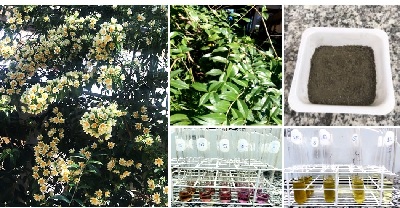Chemical characterization and antioxidant activity of ora-pro-nobis powder mucilage
DOI:
https://doi.org/10.20873/jbb.uft.cemaf.v10n3.kobayasiKeywords:
Pereskia aculeata Mill, mucilage, protein, bioactive compoundsAbstract
P
Pereskia aculeata Mill., known as ora-pro-nobis, is an unconventional food plant (PANC) that has a high protein content, surpassing many other vegetables commonly used in human food. In addition to being a source of protein, this species has bioactive compounds that give it analgesic, anti-inflammatory and antioxidant properties. Ora-pro-nobis presents a mucilage capable of acting as a thickening, emulsifying and gelling agent, characteristics due to the presence of the arabinogalactan biopolymer and its adhesion to the proteins present in the mucilage. The present study aimed at the chemical characterization and determination of the antioxidant activity of powdered ora-pro-nobis mucilage. Protein quantification showed that lyophilized mucilage has a higher protein content than fresh ora-pro-nobis leaves, with an average of 39.55% protein. The evaluation of antioxidant activity showed a positive correlation with the increase in mucilage concentration and total flavonoid content.
References
Almeida MEF, Junqueira AMB, Simão AA, Corrêa, AD. Caracterização química das hortaliças não-convencionais co-nhecidas como ora-pro-nobis. Bioscience Journal, v.30, p.431-439, 2014.
AOAC. Official Methods of Analysis. 17th Edition, The Association of Official Analytical Chemists, Gaithersburg, MD, USA. Methods 925.10, 65.17, 974.24, 992.16. 2000.
Barreira TF, Paula Filho GXD, Priore SE, Santos RHS, Pi-nheiro-Sant’ana HM. Nutrient content in ora-pro-nóbis (Pe-reskia aculeata Mill.): unconventional vegetable of the Bra-zilian Atlantic Forest. Food Science and Technology, v.41, p.47-51, 2021. https://doi.org/10.1590/fst.07920
Garcia JAA, Corrêa RCG, Barros L, Pereira C, Abreu RMV, José Alves M, Ferreira ICFR. Phytochemical profile and biological activities of “Ora-pro-nobis” leaves (Pereskia aculeata Miller), an underexploited superfood from the Bra-zilian Atlantic Forest. Food Chemistry, v.294, p.302-308, 2019. https://doi:10.1016/j.foodchem.2019.05.074
Lucyszyn N, Ono L, Lubambo AF, Woehl MA, Sens CV, Souza CF, Sierakowski MR. Physicochemical and in vitro biocompatibility of films combining reconstituted bacterial cellulose with arabinogalactan and xyloglucan. Carbohydrate Polymers, v.151, p.889-898, 2016. https://doi:10.1016/j.carbpol.2016.06.027
Lutz – IAL, Instituto Adolfo. Métodos físico-químicos para análise de alimentos. 4ª edição, 1ª Edição Digital. São Paulo: IAL. 2008.
Maciel VBV, Bezerra RQ, Chagas EGL, Yoshida, CMP, Carvalho RA. Ora-pro-nobis (Pereskia aculeata Miller): a potential alternative for iron supplementation and phytoche-mical compounds. Brazilian Journal of Food Technology, v.24, p.1-13, 2021. https://doi.org/10.1590/1981-6723.18020
Oliveira NL, Rodrigues AA, Oliveira Neves IC, Teixeira Lago AM, Borges SV, Resende JV. Development and characteri-zation of biodegradable films based on Pereskia aculeata Miller mucilage. Industrial Crops and Products, v.130, p.499-510, 2019. https://doi:10.1016/j.indcrop.2019.01.014
Pinto NC, Scio E. The biological activities and chemical com-position of Pereskia species (Cactaceae)-a review. Plant Fo-ods Hum Nutr, v.69, n.3, p.189-95, 2014. https://doi: 10.1007/s11130-014-0423-z
Souza M, Correa E, Guimarães G, Pereira P. O Potencial do Ora-pro-nobis na Diversificação da Produção Agrícola Fa-miliar. Revista Brasileira de Agroecologia, v.4, n.2, p.3550-3554, 2009.
Souza LF. Aspectos fitotécnicos, bromatológicos e componen-tes bioativos de Pereskia aculeata miller e Anredera cordi-folia, Ano de obtenção: 2014. Tese (Doutorado em Fitotec-nia) – Universidade Federal do Rio Grande do Sul, Facul-dade de Agronomia, Porto Alegre, RS.
Takeiti CY, Antonio GC, Motta EMP, Collares-Queiroz FP, Park KJ. Nutritive evaluation of a non-conventional leafy vegetable (Pereskia aculeata Miller). International Journal of Food Sciences and Nutrition, v.60, p.148-160, 2009. https://doi:10.1080/09637480802534509
Teixeira TS, Vale RC, Almeida RR, Ferreira TPS, Guimarães LGL. Antioxidant potential and its correlation with the con-tents of phenolic compounds and flavonoids of methanolic extracts from different medicinal plants. Revista Virtual de Química, v.9, n.4, p.1546-1559, 2017. https://doi:10.21577/1984-6835.20170090
Telles C, Matos JDM, Madeira N, Mendonca JL, Botrel N, Junqueira A, Silva DB. Pereskia aculeata: ora-pro-nobis. In: Vieira RF, Camillo J, Coradin L. (Ed.). Espécies nativas da flora brasileira de valor econômico atual ou potencial: plantas para o futuro: Região Centro-Oeste, Brasília, DF: MMA (Série Biodiversidade; 44). p.280-289, 2016.
Zappi D, Taylor N, Santos MR, Larocca J. 2015. Cactaceae in Lista de Espécies da Flora do Brasil. Jardim Botânico do Rio de Janeiro. Disponível em: http://floradobrasil.jbrj.gov.br/jabot/floradobrasil/FB1682

Downloads
Published
How to Cite
Issue
Section
License
Copyright (c) 2023 Tamiris Machado Kobayasi, Darío Abel Palmieri, Mônica Rosa Bertão

This work is licensed under a Creative Commons Attribution 4.0 International License.
Copyright (c) 2024 - Journal of Biotechnology and Biodiversity

This work is licensed under a Creative Commons Attribution 4.0 International License.
Authors who publish with this journal agree to the following terms:
Authors retain copyright and grant the journal right of first publication with the work simultaneously licensed under a Creative Commons Attribution License (CC BY 4.0 at http://creativecommons.org/licenses/by/4.0/) that allows others to share the work with an acknowledgement of the work's authorship and initial publication in this journal.
Authors are able to enter into separate, additional contractual arrangements for the non-exclusive distribution of the journal's published version of the work (e.g., post it to an institutional repository or publish it in a book), with an acknowledgement of its initial publication in this journal.
Authors are permitted and encouraged to post their work online (e.g. in institutional repositories or on their website) prior to and during the submission process, as it can lead to productive exchanges, as well as earlier and greater citation of published work (Available at The Effect of Open Access, at http://opcit.eprints.org/oacitation-biblio.html).


